The Samsung Galaxy Tab S2 Review
by Brandon Chester on October 15, 2015 8:00 AM ESTSystem Performance: GPU
While CPU performance characterizes one part of an SoC, GPU performance characterizes another. Tablets have long been a form factor where GPU performance can be pushed much further than in a phone due to the larger chassis of a tablet having far fewer size and thermal limitations. While some tablets elect to use specialized SoCs with more powerful GPU hardware than smartphones, the Tab S2 uses the same ARM Mali T760 GPU used in the Galaxy Note 4 Exynos.
To characterize the Tab S2's GPU performance I've run it through our standard GPU benchmarks. First up is 3DMark which actually has both a CPU and GPU component, followed by BaseMark X and GFXBench which focus more strongly on the GPU alone.
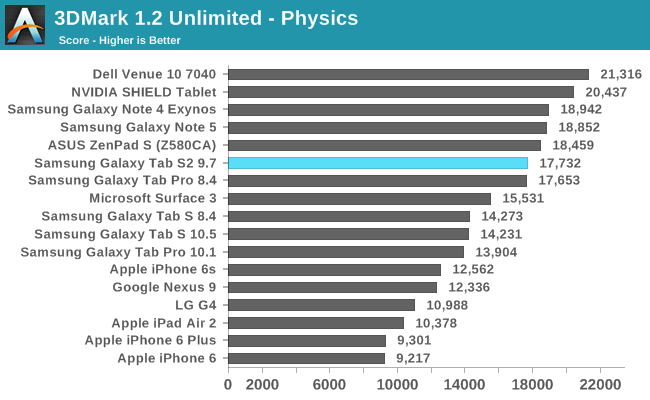


In 3DMark all of the Tab S2's scores are roughly equivalent to the Galaxy Note 4 Exynos which is not unexpected. Unfortunately, it's clear that Mali T760 can't keep up with NVIDIA's mobile Kepler implementation or Apple's custom 8 core PowerVR 6XT part. While the Nexus 9 and iPad Air 2 both fall short in the physics sub test their scores in the graphics sub test are in a completely different league than the Tab S2.
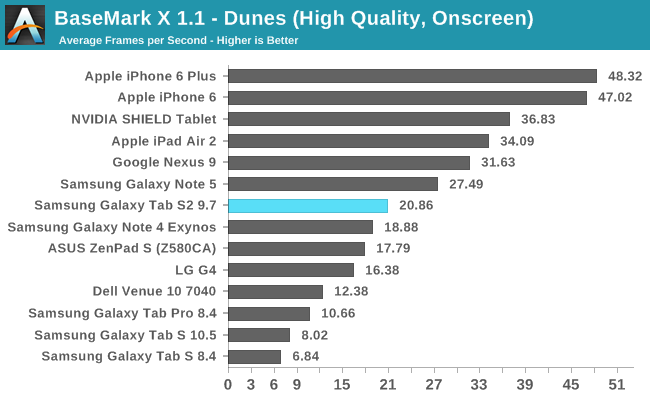
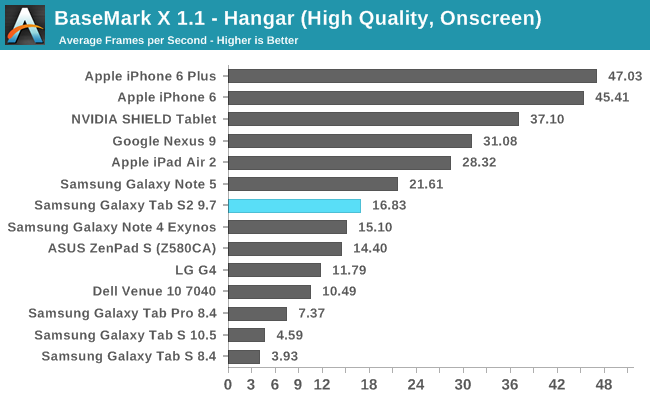
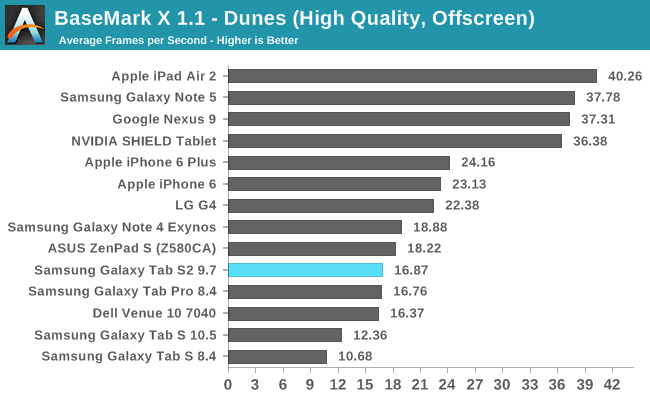
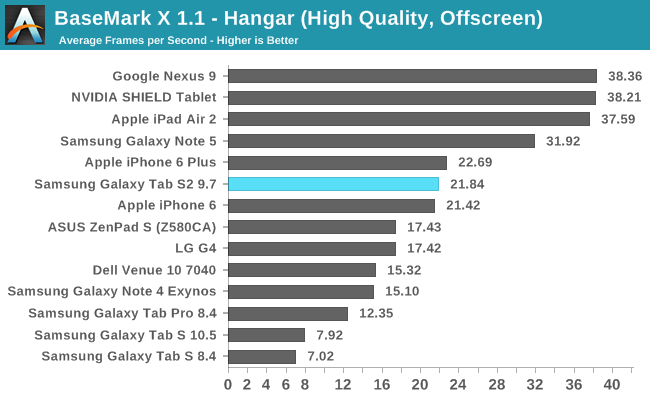
In BaseMark X we again see the Tab S2 sitting fairly far behind the iPad Air 2 and Nexus 9. If I was considering the Tab S2 8.0 which retails for $399 these results would be perfectly fine, as the major competition at that price point is the iPad Mini 4 which has Apple A8 SoC. At $499 the GPU performance simply isn't competitive, and it outlines the issues with trying to make one SoC fit many different devices.
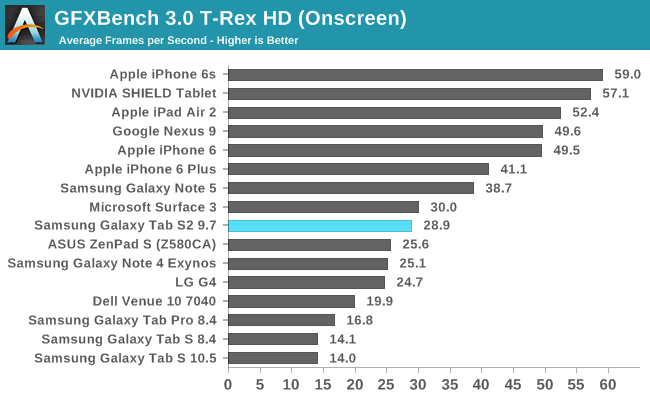
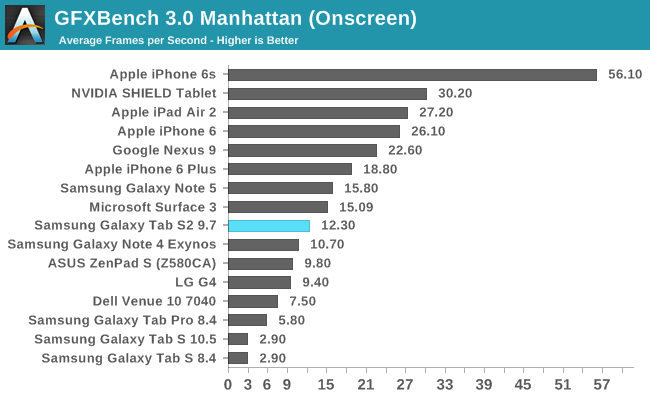
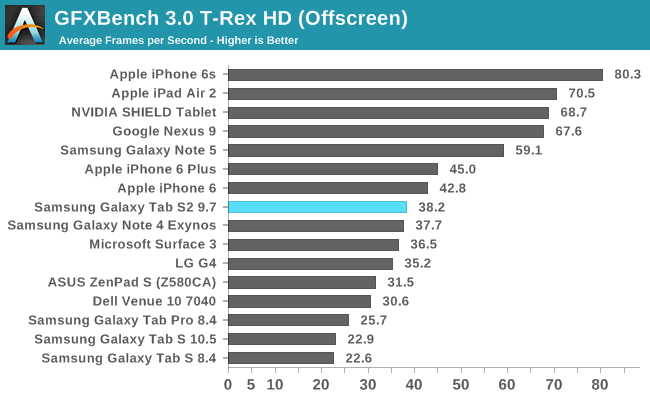
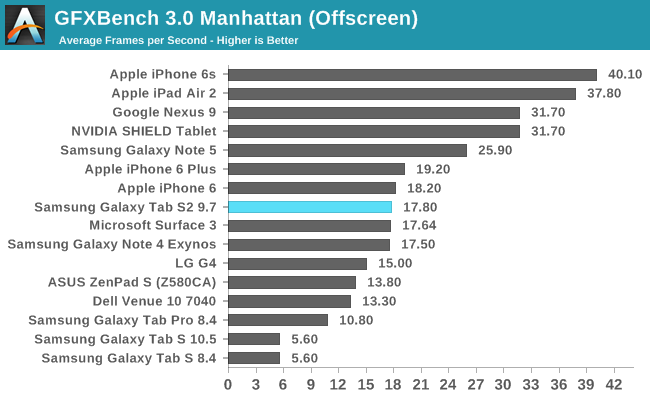
In GFXBench the Tab S2 is in the same situation as the previous tests. GPU performance is right around where the Galaxy Note 4 and iPhone 6 are, and it's just not good enough to justify the $499 price tag of the Tab S2.
Like I said on the last page, the fact that most Android tablet OEMs aren't providing CPU and GPU performance that is anywhere near competitive with the iPad Air 2 is a very bad thing for the entire tablet industry. Apple decided to not even update the iPad Air 2 despite it being a year old, and it's hard to blame them when nobody is close to them as far as performance is concerned. Having various manufacturers pushing each other to constantly improve is one of the primary drivers behind the advancements made in the mobile space, and I'm concerned that this no longer exists in the tablet market as the only tablets that come close are ones with NVIDIA's SoCs which also happen to be tablets that don't ship in very great volume.
System Performance: NAND
While it's still not advertised in specifications like on laptops, a mobile device's internal storage is now being recognized as a highly relevant part of overall system performance. Internal eMMC NAND solutions have traditionally had very poor storage performance, and different vendors have done different things to address the problem.
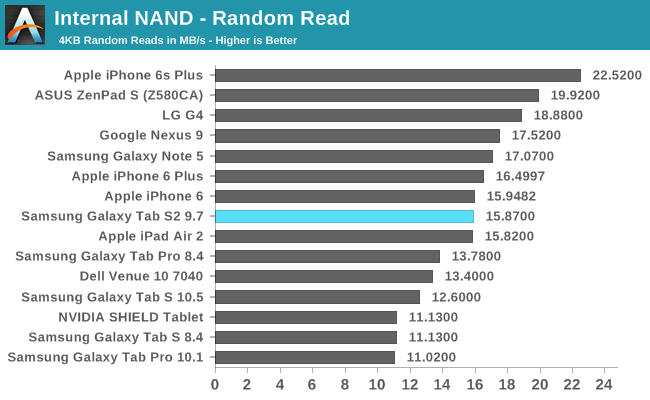
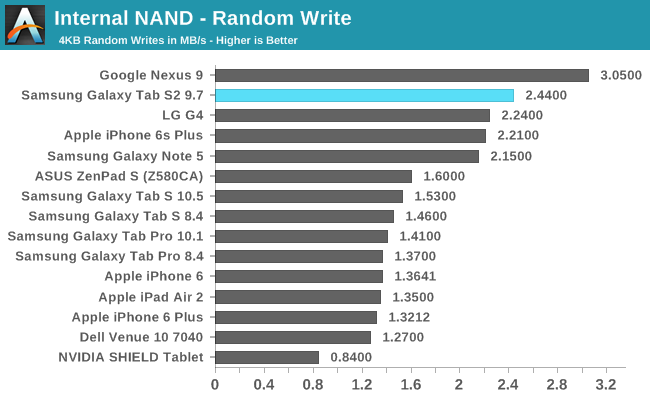
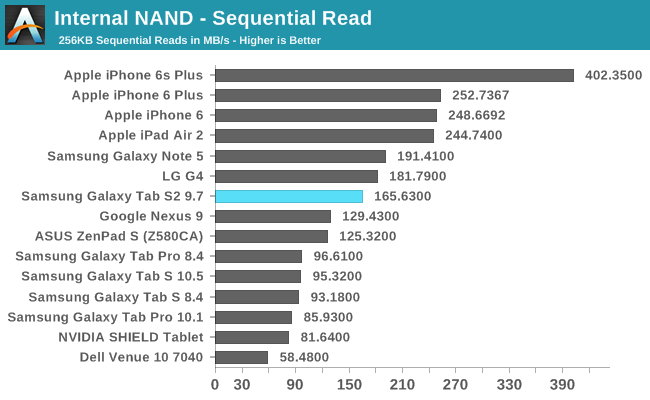
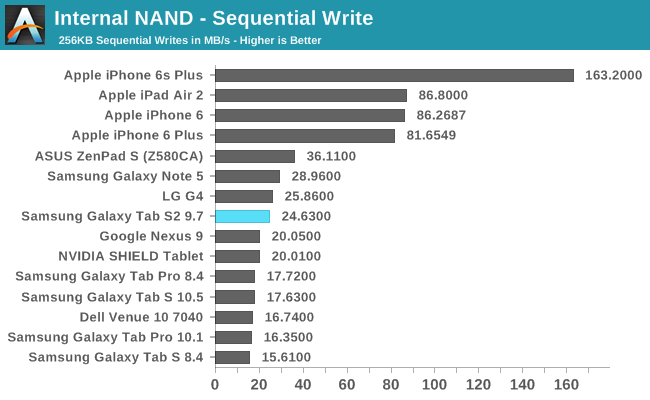
Both sets of read and write results are right around what you'd expect. Random writes in particular are very fast, and all the other results are fairly similar to those of the Galaxy Note 5. I don't expect internal NAND speeds will be a bottleneck on the Galaxy Tab S2, which is expected and fitting of a flagship tablet.










162 Comments
View All Comments
extide - Thursday, October 15, 2015 - link
You only ever get bluescreens with bad hardware or really sketchy drivers. It is not possible for pure user mode code to cause a blue screenR. Hunt - Thursday, October 15, 2015 - link
Sure, much better if you want is a laptop replacement that can occasionally serve as a tablet, but as a pure tablet, the app store, which is still a wasteland, lets it down.kmmatney - Friday, October 16, 2015 - link
This. I was really disappointed with the App store, and there is still a big disconnect between Apps and normal windows programs, even in Windows 10. I ending up selling my Windows tablet - done for now. Might try again in a few years.thedons1983 - Saturday, October 17, 2015 - link
Completely different product, and is terrible as a tablet, even with Windows 10... The windows store is an absolute joke, moreover.colonelclaw - Thursday, October 15, 2015 - link
Considering that Samsung themselves manufacture the very processors in Apple kit, then why on earth are their own tablets so pathetically underpowered? According to these benchmarks the Air2/6S is anything between 2 and 3 times faster, a crazy difference. What's going on?blackcrayon - Thursday, October 15, 2015 - link
Maybe it's cost - Apple pays Samsung to fabricate Apple designed chips. But maybe Samsung doesn't want to pay Samsung (so to speak) to develop a similar design or would just rather use an existing chip to save development costs. After all, Samsung is incorporating close to "off the shelf " ARM cores (lower dev cost) vs. Apple's custom designed cores, & Apple is in the position to specifically optimize their OS and developer tools for it.limitedaccess - Thursday, October 15, 2015 - link
There is a two fold issue here.Apple uses their latest and highest power design for their largest SKUs. While Samsung for the Tab S line for two generations has basically used what can be considered their last gen design.
blackcrayon - Thursday, October 15, 2015 - link
(And as for the GPU, Apple is just using more / faster GPU cores than Samsung is choosing to, again cost I presume since nothing stops Samsung from using another especially in a tablet).lilmoe - Thursday, October 15, 2015 - link
The SoC price difference is easily mitigated with the price difference of the screen. For the same size/resolution, AMOLED is considerably more expensive than the best LCD.Outside of benchmarks, for the average users, the performance difference isn't THAT perceivable. Anandtech are heavily concentrating their "performance difference" pm browser javascript benchmarks, which aren't the whole picture when it comes to browsing speed. Both browsers on the Tab and iPad perform almost the same as most users see it. Don't forget, Android on Samsung's devices take full advantage of all the extra cores.
As Samsung sees it, users most probably prefer a better screen over faster performance. There's lots of merit to that compromise.
FlyBri - Thursday, October 15, 2015 - link
@lilmoe I have to totally disagree with you that the SoC price difference is mitigated with the price difference of the screen. Don't get me wrong, AMOLED screens are great (I have a Note 5 and Tab S 10.5), but the LCD screen on an iPad Air 2 is pretty damn good (I have one as well), and would be more than happy using that LCD if that meant getting a much more powerful SoC and a better overall tablet for the same price, or cheaper (which the Air 2 is). And you say that for average users the performance difference isn't perceivable -- except if you're playing graphics intensive games, which some average users do -- and the iPad Air 2 completely blows the Tab S2 out of the water, even though the Air 2 is already a year old. Also, many "average users" do a lot of web browsing and reading -- heck, Samsung copied the iPad's 4:3 aspect ratio because they felt more users are doing just that. Yet in exactly those scenarios, the Tab S2's battery life is absolutely horrible and completely unacceptable.People may prefer a better screen over performance, but in the specific scenario between the screens in the Air 2 and Tab S2, I don't think there is really any merit to excuse the difference in performance, battery life, and overall tablet experience. If you can now get an Air 2 for $350-400, the Tab S2, even if you factor in the more expensive AMOLED screen, is worth $300, maybe $350, but not $500. If Samung had to switch to a top quality LCD panel to give me a true Air 2 rival in terms of performance, battery life, tablet experience, etc., I'd happily go with that every single time.